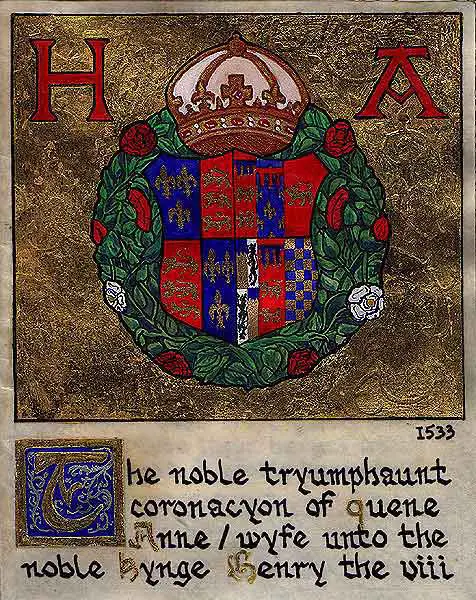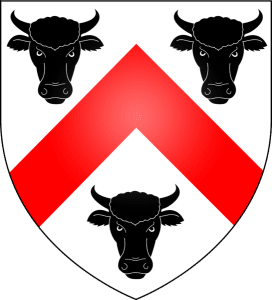
The arms of four of Henry VIII’s wives have always been controversial in the world of heraldry because Henry VIII granted Anne Boleyn, Jane Seymour, Catherine Howard and Catherine Parr augmentations, going against the ‘norms’ of heraldry.
In “A Treatise on Heraldry, British and Foreign: With English and French Glossaries”, John Woodward and George Burnett give Anne Boleyn’s arms as an example of “the perversion of the true historical spirit of heraldry of which the reigns of Henry VIII and his immediate successors are only too full of examples”.1 In “Heraldry, Historical and Popular” Charles Boutell called Anne’s arms “a striking illustration of the degenerate condition of Heraldry under the Tudor Sovereign.”2
What was this perversion?
J.H. and R.V. Pinches point out in “The Royal Heraldry of England” that Anne Boleyn’s arms were “composed of those of the principal houses from which she was descended on her mother’s side, however remote”3 and also those of her father’s maternal family, the Butlers. Her father’s Boleyn arms, which were “Argent, a chevron gules between three bulls’ heads couped sable”, were completely omitted. Anne’s “supporters” were “Dexter, A leopard gorged with a royal Coronet pendant there from a chain reflexed over the back or; Sinister, A male griffin argent, armed and tufted or, Similarly gorged and chained.”4
The arms granted to Anne Boleyn in 1532 were “Quarterly of six; lst, England, a label of France (Duchy of Lancaster); 2nd, France ancient a label gules (Anjou-Naples); 3rd, Gales, a lion passant guardant or Acquitaìne); 4th, Quarterly, I and IV, Or, a chief indented azure (Butler), II and III, Argent, a lion rampant sable crowned gules (Rochford); 5th, England, a label argent (Thomas of Brotherton); 6th, Chequy or and azure (Warren).”5

This “perversion” and “degeneration” of heraldry in Anne’s arms has been used by some6 as evidence that Anne Boleyn was ashamed of her paternal roots, the Boleyn family and their merchant background. However, we can’t make assumptions about Anne Boleyn’s feelings. Do we have evidence that she was ashamed of the Boleyns? No, we don’t.

More importantly, Anne Boleyn’s arms were not created by Anne, they were granted by Henry VIII when he made her Marquis of Pembroke in 15327 and the augmentations were also made by him. Although Woodward, Burnett and Boutell sneer at the “perversion” and “degeneration” of heraldry in Anne’s arms, they do not blame Anne in any way, they blame Henry VIII and talk of how his reign was full of such examples. Woodward and Burnett explain:
“Augmentations are additions made by the Sovereign to the coat of arms of an individual as a recognition of services rendered to the Prince or to the State; or merely as evidence of princely favour. They sometimes
take the form of additional quarterings; but more commonly consist of a chief, canton, or an escucheon to be
borne thenceforth as an integral part of the hereditary coat Many of them are exceedingly interesting as
historical memorials.”8
In his book, “A Complete Guide to Heraldry”, Arthur Charles Fox-Davies explains that “The Crown is the Fountain of Honour, having supreme control of coat-armour” and also that “the Sovereign, as the fountain of honour, can over-ride any rule or law of Arms”.9 Fox-Davies also says:
“To those who would still maintain that a man may invent arms for himself, I would point out (I) that Henry V. decreed that arms borne without authority were to be stripped off and broken up. Charles (Brandon), Duke of Suffolk, Earl Marshal (1524-1534), ordered ‘that none shall enterprise to beare anie signs or tokens of arms, etc., withoute they be authorised so to do.’ Henry VIII., Philip and Mary, Elizabeth, Charles I. and Charles II., all in their Commissions commanding Visitations to be made, and in other Warrants and Orders, decreed that false arms were to be defaced; the Kings of Arms made those disclaim who would not rectify their arms.”10

Anne Boleyn was not queen when her arms were created, she was a commoner being raised to be a marquis and she had no right or authority to commission arms, Henry VIII would have done so from the College of Arms.
I cannot say 100% that shame had nothing to do with the Boleyn arms being omitted from Anne Boleyn’s arms, but it is more likely, seeing that the arms were Henry VIII’s responsibility, that he wanted to emphasise Anne’s noble heritage. Henry VIII was raising Anne Boleyn to be Marquis of Pembroke to make her a worthy consort and to fit her for the couple’s upcoming visit to Calais, a visit which they hoped would see Francis I give their proposed marriage his support and blessing. Henry VIII was trying to annul his marriage to a Spanish princess and replace her with a ‘commoner’ so it was important to emphasise Anne’s descent from the Howards and Butlers, the lines which gave her royal blood and nobility.
Henry VIII may have broken some of the established rules governing heraldry but then, as heraldry expert Peter de Lisle11 explained to me, Henry, as King, was “the font of all honour” and could do whatever he wanted. Henry VIII granted Coats of Augmentation to all his English wives – Catherine of Aragon and Anne of Cleves didn’t need them as they were already noble enough – and although Anne’s arms were unusual, in that her paternal arms were omitted, Henry VIII and the heralds were in charge of Anne’s arms, not Anne.
So, should we assume from Anne’s arms that she was ashamed of her roots?
No, of course not. We cannot even assume that Henry was ashamed of Anne’s roots, he was simply emphasising that which made her a worthy consort in the eyes of the people. Christopher Wordsworth, editor of “Ecclesiastical Biography, Or, Lives of Eminent Men, Connected with the History of Religion in England” (1853), came up with another theory for the omission of the Boleyn bull on Anne’s arms. He wrote that it was “from a probable desire, on the part of Henry, to nullify the coarse allusion in the proverb repeated by Wolsey”12, the Dun Cow prophecy:
“When the cow rideth the bull,
Then, priest, beware thy scull.”
George Cavendish, Cardinal Wolsey’s gentleman usher, wrote of how the cow represented the King and the bull represented Anne Boleyn:
“For this cow the king gave as one of his beasts appertaining of antiquity unto his earldom of Richmond, which was his ancient inheritance; this prophecy was after expounded in this wise. This dun cow, because it was the king’s beast, betokened the king; and the bull betokened Mistress Anne Boleyn, which was after queen, because that her father, Sir Thomas Boleyn, gave the same beast in his cognisance. So that when the king had married her, the which was then unknown to my lord, or to any other at that time, then was this prophecy thought of all men to be fulfilled. For what a number of priests, both religious and secular, lost their heads for offending of such laws as were then made to bring this [marriage] to effect…”13
An interesting theory and at least it credits Henry with the omission, and not Anne.
Conclusion – Another Boleyn Myth
 We cannot know Anne’s feelings on the subject, they are not recorded and we cannot ‘assume’ anything.
We cannot know Anne’s feelings on the subject, they are not recorded and we cannot ‘assume’ anything.
My own feeling, seeing as his wife’s arms were down to Henry VIII as King (and the College of Arms), is that the idea that the omission of the Boleyn bull from Anne Boleyn’s arms is evidence of her shame is a load of ‘bull’ – sorry, just had to say that! Remember, arms were, at the end of the day, a form of propaganda.
This one gets our Boleyn Myth stamp.
Next Time
The next article in this series will continue the theme of Anne Boleyn being ashamed of her roots and will examine the claim that Anne Boleyn commissioned a fabricated family tree.
Notes and Sources
- “A Treatise on Heraldry, British and Foreign: With English and French Glossaries”, John Woodward and George Burnett, (1892), p529
- “Heraldry, Historical and Popular”, Charles Boutell, (1864), p309
- “The Royal Heraldry of England”, J.H. and R.V. Pinches, (1974), p144
- Ibid.
- Ibid.
- “The daring truth about Anne Boleyn: cutting through the myth”, Sylwia Zupanec, (2012)
- Ibid., “Ecclesiastical Biography: Or, Lives of Eminent Men, Connected with the History of Religion in England”, Christopher Wordsworth, (1853), p613, notes on Cavendish’s record of Wolsey.
- Woodward and Burnet, p528
- “A Complete Guide to Heraldry”, Arthur Charles Fox-Davies, (1909), pix, p27
- “The Right to Bear Arms”, Arthur Charles Fox-Davies, (1900), p199
- Peter de Lisle, European Heraldry
- Wordsworth, p613
- Ibid., “The Life of Cardinal Wolsey, Volume 1”, George Cavendish, p234
Bibliography
In addition to those sources listed above:
- “Bagford’s Notes on Bookbindings”, p128 in “Transactions of the Bibliographical Society of Great Britain: Volume VII”, October, 1902, to March, 1904
- Anne Boleyn’s Heraldry
- “English Heraldry”, Charles Boutell, (1867)
- “A History of the College of Arms, and the Lives of All the Kings, Heralds, and Pursuivants from the Reign of Richard III”, Rev. Mark Noble, (1804)
- Modern version of Boleyn Family arms -NinjaKid (Ollie Martin), 2012.
- Modern version of Anne Boleyn’s arms as queen – Sodacan, Coat of Arms of Queen Anne Boleyn, 8 October 2010, https://commons.wikimedia.org/wiki/File:Coat_of_Arms_of_Anne_Boleyn.svg.